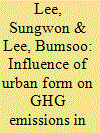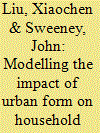|
|
|
Sort Order |
|
|
|
Items / Page
|
|
|
|
|
|
|
| Srl | Item |
| 1 |
ID:
125598


|
|
|
|
|
| Publication |
2013.
|
| Summary/Abstract |
Using 1997 personal trip survey (PTS) data in the Kumamoto metropolitan area, this paper examined the influence of urban form on energy consumption through an energy estimation model from a microeconomic perspective. As all goods and service are assumed to satisfy the need of people, we estimated the individual energy consumption based on the demand of goods, which is explained by a utility maximization problem constrained by income. 52.84 GJ of energy is estimated for one person one year in Kumamoto metropolitan area. 19.57% of energy is used for mobility goods. A spatial regression was performed to analyze the relationship between energy efficiency and urban form characteristics in terms of density, diversity, and accessibility. The results of regression analysis show that employment density, ratio of employee in retail department, transit fare, and distance to city center are the most influential factors of energy efficiency. Findings suggest compact development and integrated policies for increasing employment density, especially, employment proportion of local residents are suggested. Moreover, measures to improve the attractiveness of mass transit should be encouraged to increase energy efficiency in Kumamoto.
|
|
|
|
|
|
|
|
|
|
|
|
|
|
|
|
| 2 |
ID:
126551


|
|
|
|
|
| Publication |
2013.
|
| Summary/Abstract |
Household consumption requires energy to be used at all stages of the economic process, thereby directly and indirectly leading to environmental impacts across the entire production chain. The levels, structure and determinants of energy requirements of household consumption therefore constitute an important avenue of research. Incorporating the full upstream requirements into the analysis helps to avoid simplistic conclusions which would actually only imply shifts between consumption categories without taking the economy wide effects into account. This paper presents the investigation of the direct and indirect primary energy requirements of Australian households, contrasting urban, suburban and rural consumption patterns as well as inter- and intra-regional levels of inequality in energy requirements. Furthermore the spatial and socio-economic drivers of energy consumption for different categories of energy requirements are identified and quantified. Conclusions regarding the relationships between energy requirements, household characteristics, urban form and urbanization processes are drawn and the respective policy implications are explored.
|
|
|
|
|
|
|
|
|
|
|
|
|
|
|
|
| 3 |
ID:
098259


|
|
|
|
|
| Publication |
2010.
|
| Summary/Abstract |
Energy-saving technologies' applicability to making cities more environmentally sustainable can be strongly influenced by the city's form, building uses and their density pattern. Technological developments have clearly shown specific urban forms to be more conducive to installing certain mitigation technologies. In this study, the capacity for implementation and impacts on energy savings and subsequent greenhouse gas (GHG) reduction potential of mitigation technologies such as photovoltaic cells (PV) and combined heat and power (CHP) technologies were analysed with respect to three potential urban forms (high density centralised, medium density averaged and low density de-centralized) for Utsunomiya City, Japan. Given current building use patterns, scenarios for 2030 and 2050, showed the medium density averaged form, which benefits from both PV and CHP technologies, to outperform the other forms, resulting in an energy savings and GHG reduction potential of 27.6% in 2030 and 67.6% in 2050. Interestingly, GHG reduction in 2050 was primarily attributable to PV, while CHP technology had the greater influence in 2030. Despite the limitation of the analysis, the study provides a useful insight, highlighting the relationship between urban forms and GHG reduction potential by two energy-saving technologies.
|
|
|
|
|
|
|
|
|
|
|
|
|
|
|
|
| 4 |
ID:
098554


|
|
|
|
|
| Publication |
2010.
|
| Summary/Abstract |
Energy-saving technologies' applicability to making cities more environmentally sustainable can be strongly influenced by the city's form, building uses and their density pattern. Technological developments have clearly shown specific urban forms to be more conducive to installing certain mitigation technologies. In this study, the capacity for implementation and impacts on energy savings and subsequent greenhouse gas (GHG) reduction potential of mitigation technologies such as photovoltaic cells (PV) and combined heat and power (CHP) technologies were analysed with respect to three potential urban forms (high density centralised, medium density averaged and low density de-centralized) for Utsunomiya City, Japan. Given current building use patterns, scenarios for 2030 and 2050, showed the medium density averaged form, which benefits from both PV and CHP technologies, to outperform the other forms, resulting in an energy savings and GHG reduction potential of 27.6% in 2030 and 67.6% in 2050. Interestingly, GHG reduction in 2050 was primarily attributable to PV, while CHP technology had the greater influence in 2030. Despite the limitation of the analysis, the study provides a useful insight, highlighting the relationship between urban forms and GHG reduction potential by two energy-saving technologies.
|
|
|
|
|
|
|
|
|
|
|
|
|
|
|
|
| 5 |
ID:
133265


|
|
|
|
|
| Publication |
2014.
|
| Summary/Abstract |
To better understand the role of sustainable urban development in greenhouse gas (GHG) mitigation, this study examines the paths by which urban form influences an individual household×s carbon dioxide emissions in the 125 largest urbanized areas in the U.S. Our multilevel SEM analyses show that doubling population-weighted density is associated with a reduction in CO2 emissions from household travel and residential energy consumption by 48% and 35%, respectively. Centralized population and polycentric structures have only a moderate impact in our analyses. Given that household travel and residential energy use account for 42% of total U.S. carbon dioxide emissions, these findings highlight the importance of smart growth policies to build more compact and transit friendly cities as a crucial part of any strategic efforts to mitigate GHG emissions and to stabilize climate.
|
|
|
|
|
|
|
|
|
|
|
|
|
|
|
|
| 6 |
ID:
125603


|
|
|
|
|
| Publication |
2013.
|
| Summary/Abstract |
This research investigates the maximum potential energy that can be made available by efficiently installing photovoltaic (PV) systems on buildings throughout a city, from the central business district (CBD) out to low density suburbs. The purpose of this is to evaluate the contribution that electricity from PVs can make to reduce the electricity load of a city, supply the needs of a mixture of building types, reduce peak electricity demand and contribute towards the charging of electric vehicles (EVs). Having established the maximum potential, intermediate stages in PV penetration can be backcasted. The results indicate that low dense suburbia is not only the most efficient collector of solar energy but that enough excess electricity can be generated to power daily transport needs of suburbia and also contribute to peak daytime electrical loads in the city centre. This challenges conventional thinking that suburbia is energy inefficient. While a compact city may be more efficient for the internal combustion engine vehicles, a dispersed city is more efficient when distributed generation of electricity by PVs is the main energy source and EVs are the means of transport.
|
|
|
|
|
|
|
|
|
|
|
|
|
|
|
|
| 7 |
ID:
112916


|
|
|
|
|
| Publication |
2012.
|
| Summary/Abstract |
This study aims to investigate the relationship between household space heating energy use and urban form (land use characteristics) for the Greater Dublin Region. The geographical distributions of household energy use are evaluated at the Enumeration Districts (ED) level based on the building thermal balance model. Moreover, it estimates the impact of possible factors on the household space heating consumption. Results illustrate that the distribution profile of dwellings is a significant factor related to overall heating energy demand and individual dwelling energy consumption for space heating. Residents living in compact dwellings with small floor areas consume less energy for space heating than residents living in dwellings with big floor areas. Moreover, domestic heating energy demand per household was also estimated for two extreme urban development scenarios: the compact city scenario and the dispersed scenario. The results illustrate that the compact city scenario is likely to decrease the domestic heating energy consumption per household by 16.2% compared with the dispersed city scenario. Correspondingly, the energy-related CO2 emissions could be significantly decreased by compact city scenario compared with the dispersed city scenario.
|
|
|
|
|
|
|
|
|
|
|
|
|
|
|
|
| 8 |
ID:
117320


|
|
|
|
|
| Publication |
2013.
|
| Summary/Abstract |
Urban areas are recognised to be significant global energy consumers, and therefore high CO2 emitters, making energy management at urban scales a relevant research focus. However, one of the main obstacles faced with upgrading existing urban systems to meet target energy reductions is the current rate of refurbishment and new build, where it is estimated that 75% of existing buildings will still be in place by 2050. Moreover limited renewable resources and predicted warming trends place further limitations on policies aimed at carbon management. This paper examines current thinking around energy management associated with building operational and regulated loads and the role of urban form. Its focus is on cooling loads for office buildings in central London and offers a new perspective on energy management at an urban scale by demonstrating (within the 25% redevelopment rate) that when building energy management is considered within an urban context, the overall performance of an urban system can be significantly improved. The work highlights the often overlooked role of urban form on building energy performance (both individually and in combination) and demonstrates that as we move towards a low energy future; the role of urban form becomes increasing significant.
|
|
|
|
|
|
|
|
|
|
|
|
|
|
|
|
| 9 |
ID:
169848


|
|
|
|
|
| Summary/Abstract |
Transportation energy is a significant portion of the energy consumption of the US economy. While various policies such as changing the fuel mix and alternative fuels are proposed to make the system more efficient, the efficacy of land use policies such as changing the urban form and densification have been subject to considerable debate. In this paper, I use a rich dataset compiled from different sources to test the effectiveness of urban form on energy consumption in the transportation sector. I proxy the consumption with retail sales from gas stations for most of the conterminous United States at a county level. Using demographic, economic and landscape characteristics, I tease out the effect of different dimensions of urban form on energy consumption. I find that compact and contiguous urban form is modestly associated with lower energy consumption and is more important than demographic concentration in explaining the variance.
|
|
|
|
|
|
|
|
|
|
|
|
|
|
|
|
|
|
|
|
|